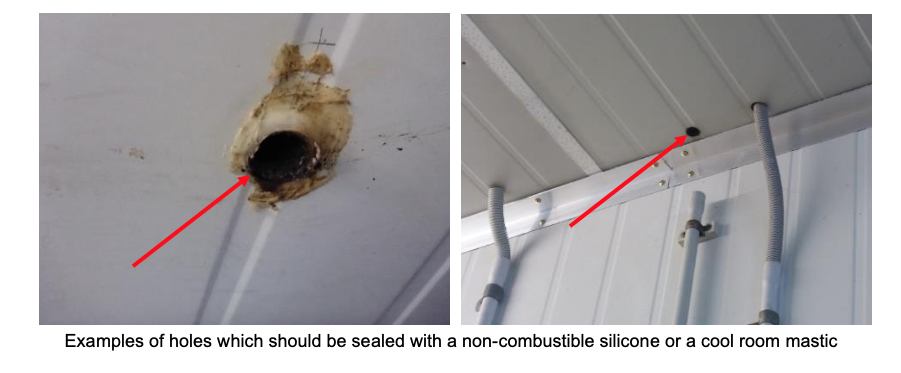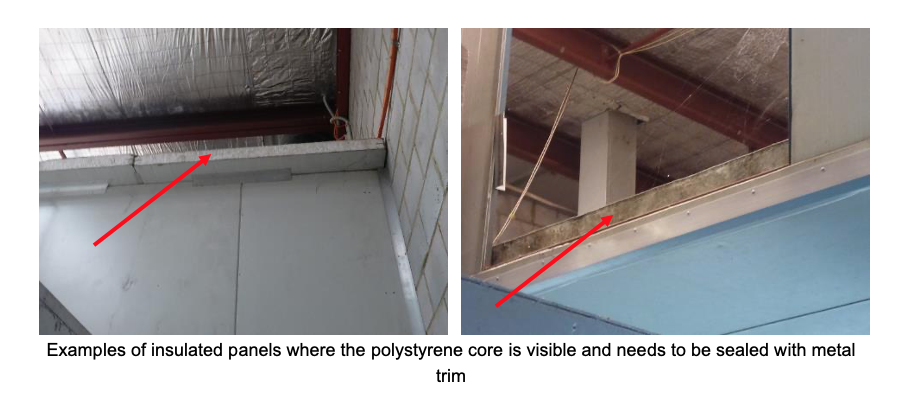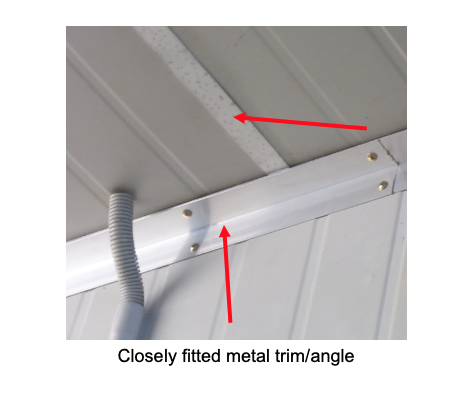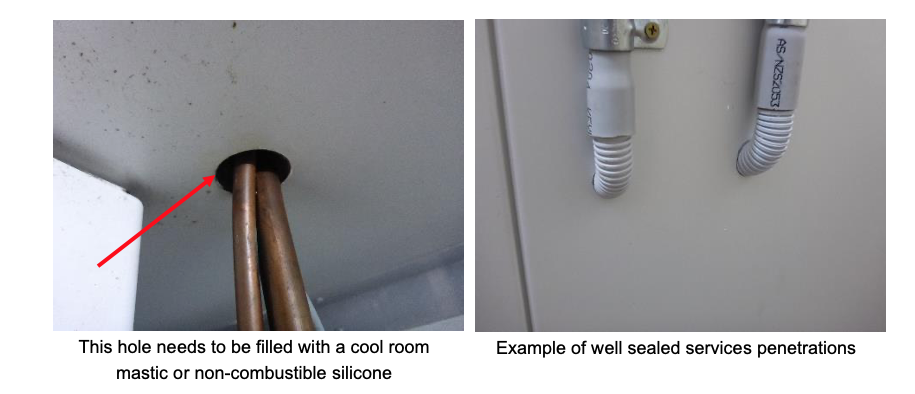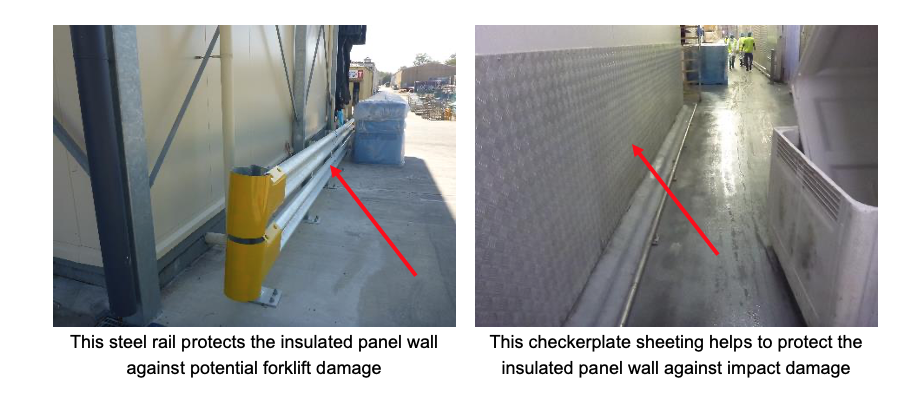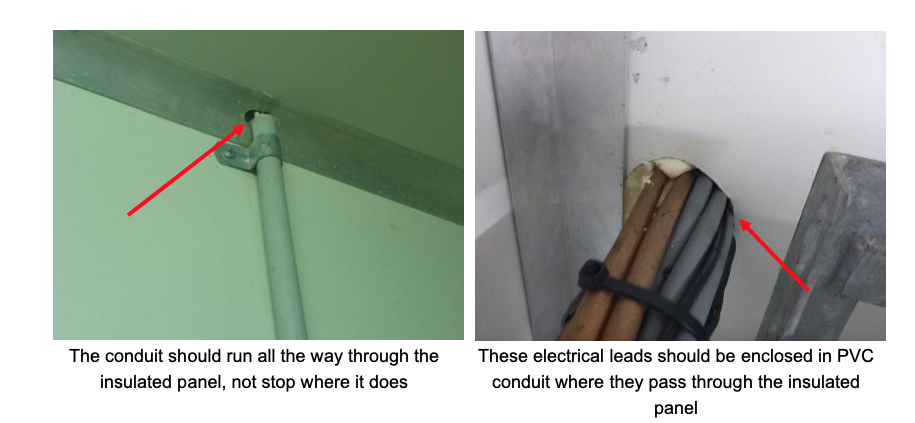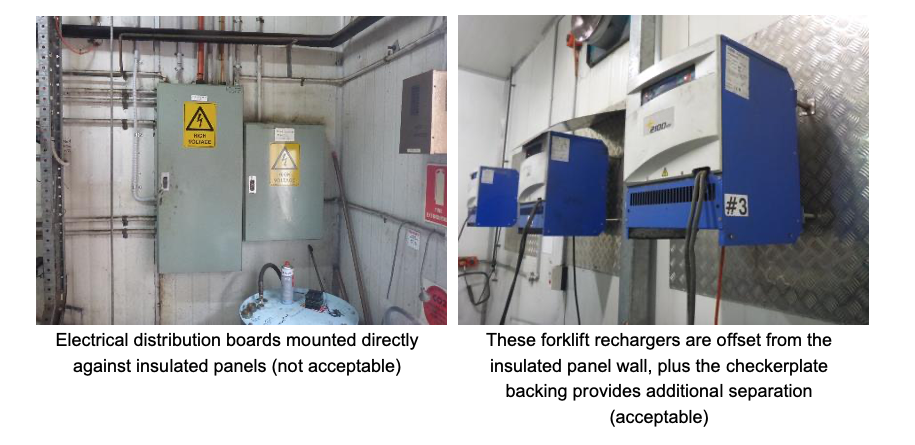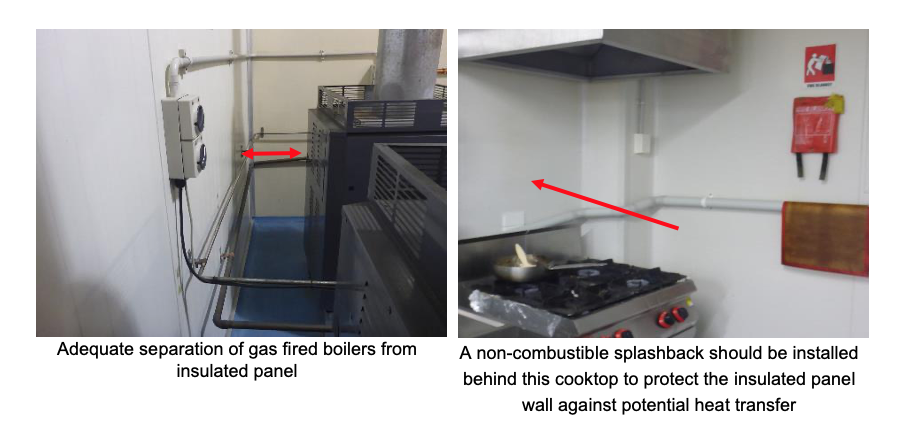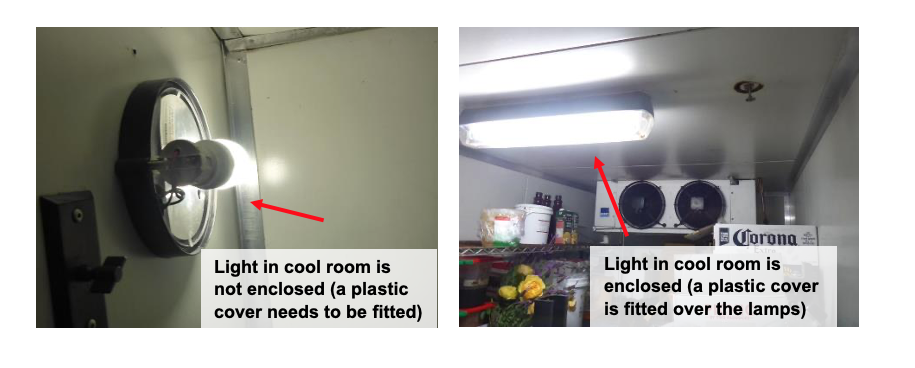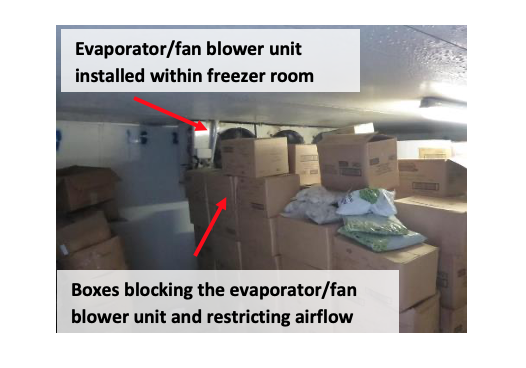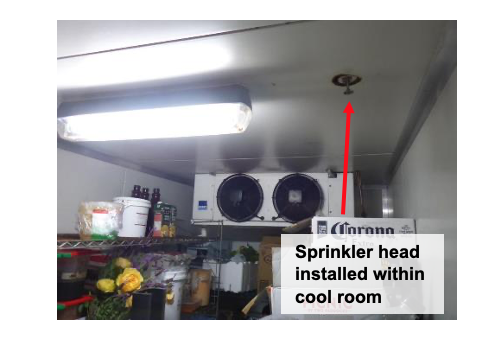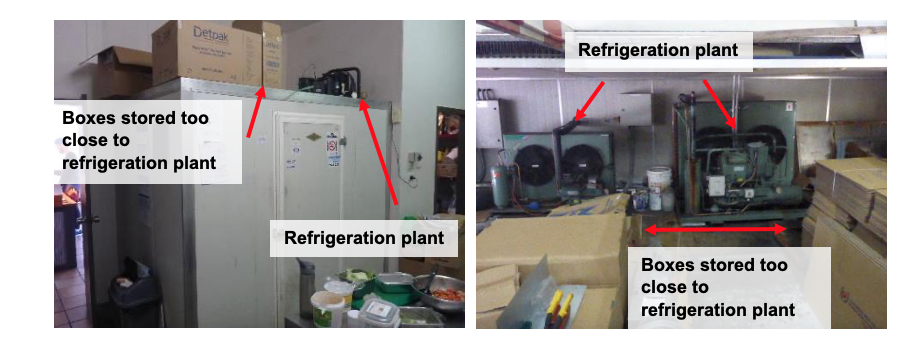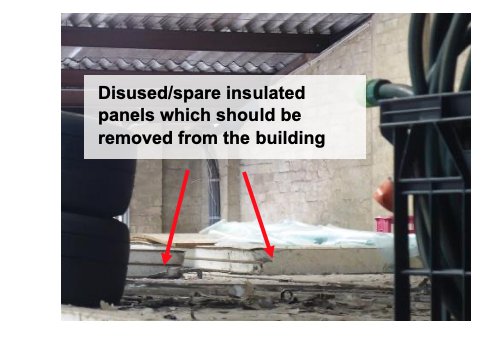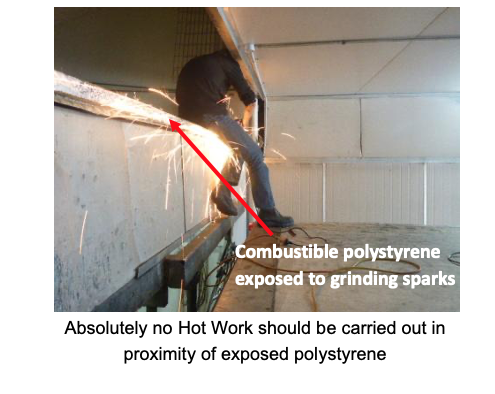Title Page
-
Site conducted
-
Conducted on
-
Prepared by
-
Location
INSULATED PANEL INSPECTION CHECKLIST
-
Are there any holes in the insulated panels which have resulted in the core materials being exposed? All holes in the insulated panels should be fully sealed with an approved cool room mastic, or a non-combustible silicone so that none of the core materials are exposed. Most core materials are expanded polystyrene, which is highly combustible, and should be protected from potentially coming into contact with an ignition source.
-
Are there any holes in the insulated panels which have resulted in the core materials being exposed?
-
Are there sections of the insulated panels which have not been properly enclosed, allowing you to see the core material? Sometimes the installation of insulated compartments is not completed, leaving sections of the core material exposed/visible. It is important that such issues are addressed immediately so that the cores are completely sealed and not exposed to potential ignition sources.
-
Are there sections of the insulated panels which have not been properly enclosed, allowing you to see the core material?
-
Is there metal trim fitted to the corners and panel joins where required, and does this trim fit tightly against the panels so that there are no gaps between the trim and the panel skins? Fitting metal trim and angle pieces tightly against the corners inside cool rooms, and also at the ends of insulated panels ensures that the combustible core materials of the panels are well sealed and not exposed to potential ignition sources.
-
Is there metal trim fitted to the corners and panel joins where required, and does this trim fit tightly against the panels so that there are no gaps between the trim and the panel skins?
-
Are there any services penetrations (where electrical cabling or fluid/vapour pipes pass through the panels) that have not been completely sealed? All services penetrations through the insulated panels should be fully sealed with an approved cool room mastic, or a non-combustible silicone so that none of the core materials is exposed.
-
Are there any services penetrations (where electrical cabling or fluid/vapour pipes pass through the panels) that have not been completely sealed?
-
Is impact protection installed against, or adjacent to the panels to minimise the potential for forklifts or pallet jacks to damage the panels (only applicable where mobile plant is utilised in vicinity of the panels). It is possible for forklifts or other mobile plant items to impact the insulated panels and breach the outer steel skin, resulting in the panel cores being exposed. Installing bollards, rails or checkerplate sheeting assists to stop mobile plant coming into contact with the panels.
-
Is impact protection installed against, or adjacent to the panels to minimise the potential for forklifts or pallet jacks to damage the panels?
-
Consider the installation of some form of impact protection in areas of high traffic
-
Where electrical cables pass through the panels, are they completely enclosed in PVC or similar conduit? Electrical leads/cabling/wiring should not be allowed to come into contact with the steel sheeting or core material of insulated panels. The section of steel sheeting that has been cut to allow the electrics to pass through may be sharp, and if the electrical leads rub against the steel they can deteriorate, resulting in live electrical wiring coming into contact with the combustible core material within the insulated panel, creating a potential fire situation.
-
Where electrical cables pass through the panels, are they completely enclosed in a PVC or similar conduit?
-
Are there any electrical distribution boards, forklift recharger units or lithium battery packs mounted directly against the insulated panels? Due to the potential fire risk associated with electrical panels, forklift rechargers and lithium batteries it is important that these types of installations are not positioned directly against insulated panels, to reduce the possibility of flame spread/radiant heat transfer in a fire situation.
-
Are there any electrical distribution boards, forklift recharger units or lithium battery packs mounted directly against the insulated panels?
-
Are there any heating, cooking or other hazardous processes being carried out within 1m of the insulated panels? Any heating/cooking processes should be separated from adjacent insulated panels via either clear space or a non-combustible splashback/screen. This will reduce the potential for flames/heat to spread/transfer to the panels.
-
Are there any heating, cooking or other hazardous processes being carried out within 1m of the insulated panels?
-
Are all lights installed inside insulated compartments fitted with diffusers (covers)? If a light bulb or fluorescent lamp within a cool/freezer room or spray booth fails, and hot particles fall onto combustible items below (cardboard boxes or plastic wrapping in cool rooms, or coatings/overspray in spray booths) it is possible for a fire to occur. It is imperative that all lights within insulated compartments are fitted with covers (diffusers) so that in the event of a lamp failure, hot glass and ballast is contained within the cover and does not fall onto potentially combustible items below.
-
Are all lights installed inside cool and freezer rooms fitted with diffusers (covers)?
-
Are the items stored inside cool and freezer rooms kept away from the evaporator/fan blower unit? Adequate airflow must be maintained throughout cool and freezer compartments to ensure the effective cooling/freezing of stored products, and also to reduce the workload on the refrigeration plant, which will be required to work harder if stored items are blocking the evaporator/fan blower units. Items stored in cool and freezer rooms should be kept below the level of the evaporator/fan blower units and positioned so that there is an adequate flow of air throughout the room.
-
Are the items stored inside cool and freezer rooms kept away from the evaporator/fan blower unit?
-
Do the doors to cool and freezer rooms close and seal well, and are they kept closed when not in use? If the doors to cool and freezer rooms are left open, or are not well sealed when closed (similar to a standard refrigerator door), the refrigeration plant will be forced to work harder to maintain the required temperature inside the cool/freezer room, which may lead to a reduced life span, a need for more frequent maintenance, and potentially overheating which can create an increased fire risk.
-
Do the doors to cool and freezer rooms close and seal well, and are they kept closed when not in use?
-
If there is a sprinkler system installed throughout the building, have sprinkler heads been installed inside all insulated compartments as well? Where fire sprinklers are installed throughout a building, the relevant Australian Standard requires the sprinklers to be extended to the internal sections of any cool or freezer rooms within the building.
-
If there is a sprinkler system installed throughout the building, have sprinkler heads been installed inside all insulated compartments as well?
-
Have your fire protection contractor attend and investigate the feasibility of having the sprinkler heads installed to all compartments
-
Are the refrigeration motors (regardless of where they are installed) kept clear of stored items? It is important that at least 2m clear space is retained around refrigeration plant at all times to allow for adequate ventilation/airflow, and also to reduce the potential for heat or sparks (that may potentially be created by this plant) igniting combustibles stored in the vicinity.
-
Are the refrigeration motors (regardless of where they are installed) kept clear of stored items?
-
Is the refrigeration plant maintained by a third-party contractor on at least an annual basis? It is important that refrigeration plant is maintained on a scheduled basis to ensure it is operating efficiently and reduce the likelihood of it overheating and presenting a potential fire risk.
-
Are there any spare insulated panels or offcuts being stored anywhere on the site? All disused/spare insulated panel sections should be completely removed from the building/site. Storage of these panels unnecessarily increases the fire load with the building.
-
Are there any spare insulated panels or offcuts being stored anywhere on the site?
-
Ensure these are stored well separated to/from the building and potential ignition sources or removed from site
-
Has a Hot/Cold Work procedure been implemented in relation to any repair/alteration work that may need to be carried out on the panels. You should ensure that any contractors who carry out work on or in proximity of the insulated panels adhere to strict Hot/Cold Work safety controls (available from TPRM), which includes utilising only cold cut saws, riveting rather than welding, and excluding all Hot Work from areas where the panel core material is exposed.
-
Has a Hot/Cold Work procedure been implemented in relation to any repair/alteration work that may need to be carried out on the panels?
-
Reach out to your broker to supply a hot cold work procedure to be implemented across all locations.
-
Are all contractors who may carry out repair/alteration work on the insulated panels asked to provide evidence of current $20m Public Liability insurance? Any contractors who carry out work on or in proximity of the insulated panels should be required to provide evidence of Public Liability insurance so that in the event they cause damage, a recovery against their policy is possible.






